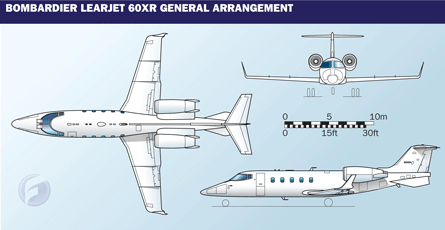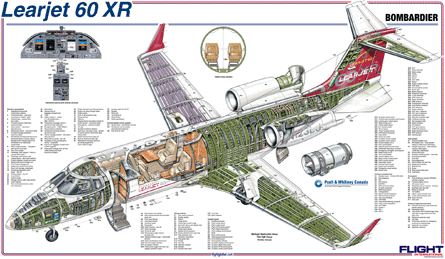When Bombardier decided to upgrade the Learjet 60, it listened to what pilots and customers wanted, including what should not be changed - its performance
When Bombardier began soliciting ideas about a possible upgrade to its mid-size Learjet 60 business jet in 2003, the company's primary customer and fractional provider subsidiary, Flexjet, responded that its pilots wanted better avionics and its customers wanted an upgraded cabin. They made no bones, however, about what should not be changed.
"We absolutely didn't want them to touch the performance," says Dave Gross, Flexjet vice-president of operations. Flexjet has 470 pilots flying 95 Bombardier-built business jets, including 12 Learjet 60s and the first four of 22 Learjet 60XRs to be delivered over the next five years. The fractional provider received its first $13.3 million Learjet 60XR in September.
What Bombardier did change is the ease with which pilots can fly the aircraft, through new avionics. "There's reduced clutter and more flight information to the pilot, increasing situational awareness and reducing workload," says Bob Agostino, Bombardier director of flight operations. In the cabin, where the previous interior "wasn't meeting the needs of the traditional customer", Agostino says there are now more layout options and improved and modernised amenities.
Cabin and avionics enhancements would be likely moot, however, without the underlying legacy of performance.
With its twin FADEC-equipped Pratt & Whitney Canada PW305A turbofans producing 4,600lb (20.46kN) thrust each, the Learjet 60XR, like its predecessor, ascends to 41,000ft (12,400m) in 18min, out-climbing all of its mid-size competitors, including the Cessna Citation Sovereign, Gulfstream G150 and Hawker 850XP.
On a demonstration flight for Flight International on 26 November, two pilots and two passengers departed Wichita Mid-Continent Airport in N60XR, the original prototype for the new aircraft. At 19,500lb take-off weight, 17% below the maximum departure weight of 23,500lb, N60XR climbed to 43,000ft in 17 min, burning a total of 770lb of fuel. The aircraft holds a maximum of 7,910lb of usable fuel in three tanks, one in each wing and one in the fuselage, providing VFR legs as long as 2,559nm (4,730km).
Climbs "like a rocket"
1977 The Learjet 55 project was first launched. The largest aircraft in the family, the Learjet 55 had a stand-up cabin, full-size lavatory and NASA-designed winglets. Powered by two Garrett AiResearch TFE731-3 turbofan engines, the seven-passenger aircraft cruised at 465kt (535mph) and could fly for 4,070km (2,200nm) at altitudes as high as 51,000ft (15,400m) 1981 Deliveries started and ultimately there were five variants, including one with a five-tube electronic flight information system built by Collins and one with delta fins under the tail. The company built 147 Learjet 55s over a 10-year period 1990 Learjet, now owned by Bombardier, launched the Learjet 60 programme. The aircraft's fuselage had been lengthened by 1.09m and engines upgraded to Pratt & Whitney Canada PW305A turbofans each providing 4,600lb (20kN) of thrust, up 900lb from the TFE731-3s. In the cockpit, the Learjet 60 included a four-tube Rockwell Collins Proline 4 avionics package, dual automatic heading and attitude reference systems and enhanced ground proximity warning system with windshear alerting 1993-97 Bombardier ultimately built 314 of the Learjet 60 series, including 39 Learjet 60 Special Edition versions 2005 Bombardier launched the Learjet 60XR (below) 2006 The aircraft was certified 2007 Deliveries began in July, starting with aircraft number 315. |
|---|
One downside of that speed from a design standpoint, at least for the legacy Learjet 60, was that approach speeds were high and the aircraft's braking action "was not the best," says Beigler. He says the heritage dual-rotor brake technologies on the Learjet 60 originally came from the lighter Learjet 31. "The 60 is a larger aircraft," he adds, "with more weight on the same brakes, hence more heat".
Along with customer input, that type of concern typically comes to the attention of Bombardier via its more than 130 field service representatives (FSRs) globally or through "abnormal aircraft situation reports", says Learjet programme manager Larry Thimmesch. Along with the FSRs, Bombardier operates a customer response centre for flight emergencies, parts, technical services and publications. The company has 27 Learjet authorised service centres worldwide, with access to $600 million in parts. Bombardier will also deliver parts using spare Flexjet capacity for US aircraft grounded for more than 24h.
Regarding the Learjet 60's brakes, Thimmesch says the original design was "adequate", but Bombardier improved the brakes in a project unrelated to the Learjet 60XR development. The three-rotor brake standard on the Learjet 60XR is also available for other models. Gross says the change is much appreciated. "There's a one-third increase in brake power (with the third rotor)," he says, adding, "From a pilot's standpoint, it's significant."
With speed reserves a given, Bombardier focused on creature comforts in the cabin and increased reliability all around. Thimmesch says Bombardier has surpassed its goal of a 99.6% dispatch reliability (DR) for the Learjet family and has set a new target of 99.7%. The company defines DR as being able to dispatch an aircraft within 15min of a request.
Part of reaching that goal is moving toward more reliable equipment on the Learjet 60XR. Thimmesch says enhancements include transitioning from incandescent bulbs to LEDs for the external navigation lights and internal cabin lights.
Touch-screen monitor
A new cabin management system makes those lights easier to adjust as well. Each seating area has a 76mm (3in) LCD Microsoft Windows-based touch-screen monitor built into the sidewall through which passengers can control functions like cabin temperature, reading lights, DVD selection, XM radio, if selected as optional equipment, and headphone volume.
"Touch screen control for passengers has been positive," says Flexjet's Gross. The Learjet 60 had dedicated switches for the functions. The new interior also has headphone jacks and 110v AC outlets at each seat as well as connections to plug MP3 players or iPods into the stereo system.
Learjet 60XR customers have their choice of five modular layouts, says Bombardier. The two most popular are an eight-seat executive layout with a three-place divan in the front and club seating for four in the rear, and a seven-passenger floorplan with club seating for two in the front and club seating for four in the back. In both configurations, a stand-up lavatory, now with two windows for more natural lighting, occupies the rear of the cabin. The new window, opposite the toilet (also certified as a seating position for takeoff and landing) had been the location of a medicine cabinet on the Learjet 60, which came standard with club seating for four and a two-place divan.
A seemingly secondary amenity - the galley - played a leading role in the redesigned cabin. "The biggest need our customers wanted was more room to prepare meals," says Gross. That translated into a larger galley with more counter and storage space and the option for a microwave oven in addition to a convection oven. He says the new design is "more functional" and includes space-saving features like a pop-out wine tray that holds three bottles - including one with a tray that holds ice. Bombardier contracted Wichita-based aircraft interior builder Hiller Incorporated to design the new interior.
Reliability and safety gains were a chief reason for the cockpit upgrade. Bombardier replaced the Learjet 60's Rockwell Collins Pro Line 4 avionics suite with the Pro Line 21 integrated avionics system linked to four 203 x 254 mm LCD screens. The aircraft comes standard with a Windows-based Rockwell Collins Integrated Flight Information System (IFIS) single file server, which allows for Jeppesen electronic chart selection linked to the flight plan in the flight management system (FMS). Approach charts for countries surveyed by the 1984 geodetic survey show own-ship position as do airport taxi diagrams, options that greatly improve situational awareness. Pilots can alter their view of the charts using a cursor control for pan and zoom control. Customers can purchase a second server system to implement a paperless cockpit, as did Flexjet for its Learjet 60XR fleet.

Edge-to-edge attitude indicator
On the primary flight display (PFD), Bombardier provides an edge-to-edge attitude indicator with an indicated airspeed tape that automatically converts to Mach number at higher speeds. Below the attitude indicator on the PFD is a horizontal situation indicator that can display overlays including weather, enhanced ground proximity warning system information and collision avoidance data.
IFIS also brings with it a Windows-based electronic checklist. "The old '60' was DOS-based," says Gross. "It was hard to edit." With the file server, Gross says Flexjet officials can make changes to the checklist and reload the new file onto the server through and RJ-45 port in the aircraft, rather than a disc drive as is used in the Learjet 60. Updated charts can also be loaded into the IFIS through the port.
Along with a second file server and XM weather and a third backup battery that provides more than 3h of emergency avionics power, Learjet 60XR optional equipment includes a 15.1in LCD cabin monitor and Rockwell Collins' WX850 weather radar, which can also be upgraded to show turbulence. Bombardier says 70% of Learjet 60XR customers order XM weather, 50% elect for a second file server, 25% purchase Honeywell's Runway Awareness and Avoidance System, 80% buy Rockwell Collins Airshow flight information system with a 15.1in video monitor, 60% purchase the Rockwell Collins WX850 weather radar, and 60% order a second Honeywell KHF-1050 long range communication radio. The aircraft comes standard with one KHF-1050 radio, making the Learjet 60XR North Atlantic-capable "out of the box", says Bombardier.
Training for pilots and mechanics is available at Bombardier's customer training centre in Dallas, Texas, where the company has a Level D Learjet 60XR simulator. Bombardier has also developed a Pro Line 21 desktop simulator for training purposes.
Source: Flight International

















